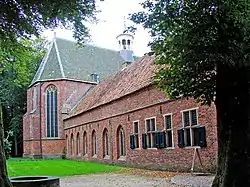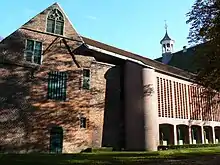 Ter Apel Monastery, church and east wing | |
| Monastery information | |
|---|---|
| Order | Canons Regular of the Order of the Holy Cross |
| Established | 1465 |
| Disestablished | 1593 |
| Mother house | Bentlage Priory, Bentlage, Rheine |
| Dedicated to | Novae Domus Lucis |
| Diocese | Roman Catholic Diocese of Osnabrück[1] (until 1593) Roman Catholic Diocese of Groningen-Leeuwarden |
| Site | |
| Location | Ter Apel, Netherlands |
| Coordinates | 52°52′34″N 7°4′28″E / 52.87611°N 7.07444°E |
| Visible remains | East, north, south wings |
| Public access | yes |
Ter Apel Monastery (Dutch: Klooster Ter Apel) is a former monastery in the village of Ter Apel in the northeastern Dutch province of Groningen. It is the only monastery in the larger area of Friesland and Groningen that survived the Reformation in a decent condition,[1] and the only remaining rural monastery from the Middle Ages in the Netherlands.[2] The convent buildings house a museum for monastery and church history and for religious art, as well as two contemporary art galleries. The former lay church of the monastery still functions as a reformed church.[3]
The monastery is located in the extreme southeast of the province of Groningen on a forested sand ridge along the ancient trade route from Münster to Groningen. For passing travelers and pilgrims, the monastery was a place of hospitality and dedication. Ter Apel is the last monastery founded in Groningen, and of 34 monasteries in the province it is the only one still recognizable as a convent.
Foundation

In 1464, Jacobus Wiltingh, pastor of Garrelsweer and vicar in Loppersum, bequeathed Apell, a settlement among his possessions in the area called Westerwolde, to the Order of the Holy Cross on the condition that a monastery be built there.[4] In May 1465, the General Chapter of the Holy Cross convened in Huy, on the Meuse, and accepted Apell as a gift from God. The monastery dedicated to Saint Gertrude of Nivelles in Bentlage, near Rheine, was to supervise the new monastery, and it sent four priests and several lay brothers to Apell, who founded the monastery and named it Novae Domus Lucis, the "House of New Light."[5] Construction, between 1465 and 1561, followed the medieval plan of the mother in Bentlage,[6] and included, besides the convent building, a gatehouse, water mills, a parchment facility, a bakery, a brewery, and a guesthouse.
The monastery was bequeathed a number of gifts, including a stained glass window in 1561 by Lieutenant Johan de Mepsche and his wife Agnes, depicting Moses and the tablets containing the Ten Commandments.[7] It also derived income from other sources. The grounds surrounding the monastery were rich in loam,[8] which was used in construction;[9] in 1492, an agreement was signed with the adjoining municipality of Roswinkel for the digging of loam,[10] on land leased by the monastery from the hamlet of Weerdinge.[11]
After the Reformation
.jpg.webp)
When the area was conquered in 1593 by William Louis, Count of Nassau-Dillenburg, Catholicism was renounced and the convent, with the entire Westerwolde area, became the property of the city of Groningen; the monastery was saved, unlike hundreds of others in the Netherlands, because the abbot converted to Protestantism.[12]
Storms, fire, and high maintenance costs caused major problems in the centuries after 1600. The monastery underwent many changes until 1930. The west facade was demolished sometime after 1755, and so were the upper floor with the brothers' cells (1834) and the dilapidated vaults in the church (1837). Unlike all the other monasteries in Groningen, a large part of the original buildings remained.
Restoration
.jpg.webp)

Between 1930 and 1933, on the initiative of the city of Groningen, the remaining buildings were carefully preserved and restored, under the direction of city engineer De Vos Nederveen Cappel. On the ground floor, three of the original four wings were retained: the church for secular canons and lay people in the south wing; the chapter house and sacristy in the east wing; and the refectory (now a cafe), the vaulted supplies cellar, the sub-prior and prior's chambers, and the guest accommodations in the north wing. These wings are connected by an ambulatory, surrounding the cloister. The original medieval cloister garden has been replaced with a herb garden; the location of this garden is the only remaining detail in the Netherlands of such a medieval garden.[13]
Since 1992 Ter Apel Monastery is listed on UNESCO's Top 100 of immovable properties in the Netherlands.[14] In 2000, the construction of a new west wing was begun, designed by Danish architect Johannes Exner; in September 2001 the work was completed.[15][16]
More renovations took place in 2007 and 2008, with a subsidy from the European Union.[17] The newly renovated scriptorium[15] features an exhibition of books and manuscripts.[18] Also newly added was a workshop for stained glass.[15] The monastery used to hold an annual chess tournament, the Klooster Internationaal Tournament,[19] and continues to organize an annual medieval festival, which in 2010 attracted some 8000 visitors.[20]
In 2009, the monastery began publishing books; the first publication was a history of medieval Dutch monasteries, De Middeleeuwse kloostergeschiedenis van de Nederlanden.[21]
See also
References
- 1 2 Bakker, Folkert Jan (2001). "Die Zisterzienser im Friesischen Gebiet". In Ulrich Knefelkamp, M. Stolpe (ed.). Zisterzienser: Norm, Kultur, Reform: 900 Jahre Zisterzienser. Springer. p. 38. ISBN 978-3-540-64816-1. Retrieved 5 October 2010.
- ↑ Stolk, Maarten (29 December 2008). "'Groninger kerken uniek in Nederland'". Reformatorisch Dagblad. Retrieved 6 October 2010.
- ↑ Soest, Aaldert van (6 August 2009). "Aflevering 3: Van pastorie tot pastorie". Nederlands Dagblad. Retrieved 6 October 2010.
- ↑ Aa, Abraham Jakob van der (1839). Aardrijkskundig Woordenboek der Nederlanden: A, Volume 1. Noorduyn. p. 293.
- ↑ Lambooij, Herman (2008). Sibrandus Leo en zijn abtenkronieken van de Friese premonstratenzerkloosters Lidlum en Mariëngaarde: een nadere studie, editie en vertaling. Verloren. p. 240 n. 38. ISBN 978-90-8704-007-9.
- ↑ Kroesen, J.; R. Steensma (2008). De Groninger Cultuurschat: kerken van 1000 tot 1800. Van Gorcum. pp. 54–56. ISBN 978-90-232-4482-0. Retrieved 5 October 2010.
- ↑ Lontzenius, Hendrik (2003). Het kasboek van Henricus Lontzenius, de laatste abt van het klooster Selwerd, over de jaren 1560-1563. Van Gorcum. pp. 71, 227. ISBN 978-90-232-3886-7.
- ↑ Staring, Winand Carel Hugo (1860). De bodem van Nederland. A.C. Kruseman. p. 26.
- ↑ Verhandelingen der tweede klasse van het Koninklijk-Nederlandsche Instituut van Wetenschappen, Letterkunde en Schoone Kunsten te Amsterdam. Royal Netherlands Academy of Arts and Sciences. 1818. pp. 63–64.
- ↑ Verslagen omtrent 'srijks oude archieven. Rijksarchief (Nederland). 1892. p. 263.
- ↑ "Weerdinge: een verdrag uit 1471". Historisch Emmen. Retrieved 5 October 2010.
- ↑ Broek, N. van den (2006). ANWB Reisgids Nederland. ANWB Media Boeken. p. 74. ISBN 978-90-18-02311-9.
- ↑ Stuip, René Ernst Victor; C. Vellekoop (1992). Tuinen in de middeleeuwen. Verloren. p. 94. ISBN 978-90-6550-243-8. Retrieved 5 October 2010.
- ↑ "'Monumenten niet op slot doen'". De Stentor. 7 March 2010. Retrieved 6 October 2010.
- 1 2 3 "Klooster Ter Apel wordt gerestaureerd". Reformatorisch Dagblad. 20 February 2007. Retrieved 6 October 2010.
- ↑ "Ter Apel - Klooster oud en nieuw". RTV Noord. Archived from the original on 20 July 2011. Retrieved 6 October 2010.
- ↑ "Klooster twee maanden gesloten wegens 'race tegen de klok'". Dagblad van het Noorden. 28 December 2007. Archived from the original on 17 July 2011. Retrieved 6 October 2010.
- ↑ Oostrom, Frits van (2009). The Netherlands in a Nutshell: Highlights from Dutch History and Culture. Amsterdam UP. p. 21. ISBN 978-90-8964-039-0.
- ↑ Byrne, Robert (21 April 1992). "Chess". The New York Times. Retrieved 6 October 2010.
- ↑ "Duizenden bezoekers voor Middeleeuws Ter Apel". Dagblad van het Noorden. 29 August 2010. Archived from the original on 17 July 2011. Retrieved 6 October 2010.
- ↑ "Ooit was de aarde bezaaid met kloosters". Dagblad van het Noorden. 3 February 2009. Archived from the original on 17 July 2011. Retrieved 6 October 2010.
Bibliography
- 500 jaar Klooster Ter Apel: van metten tot vespers. Van der Kamp, 1966.
External links
- Klooster Ter Apel (official website)